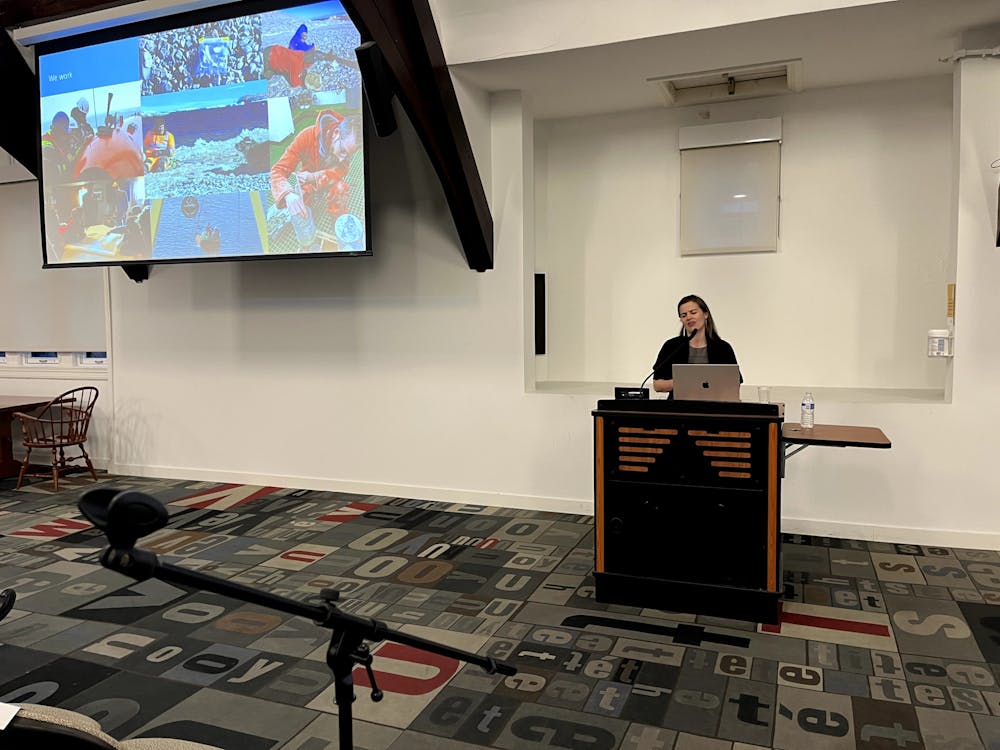The story of how English Assistant Professor of the Practice Elizabeth Rush became one of the first and only people ever to study the Thwaites Glacier in Antarctica has many beginnings.
It begins with her drive to create an archive of Antarctic stories beyond the traditional narrative of white men conquering the continent — an effort to collect stories “not preoccupied with flag planting, but with the collective and challenging work of imagining a better future,” Rush said in her presentation.
It also begins with a journey to motherhood.
Community members gathered in Pembroke Hall Monday night for Rush’s multimedia presentation “Towards an Other Antarctica,” sponsored by the Cogut Institute for the Humanities. The presentation offered a glimpse into Rush’s upcoming book, “The Quickening: Creation and Community at the Ends of the Earth,” which will be released in August.
Rush described her 2019 experience on a months-long research expedition to the Thwaites Glacier and her own journey towards motherhood, which were happening concurrently. Then in her mid-30s, Rush said she wanted to start trying to get pregnant at the time. But the expedition forced her to delay that process another year, because “pregnant people … are not allowed to sail.”
“So here I sat, drawn in two really different directions at the same time — towards Antarctica with the strange desire to see the Thwaites Glacier cap, and with this other desire to bring a human being into the world,” Rush said. “It was disorienting to hold these two opportunities aloft in my mind at the same time, one grounded in disintegration and the other in creation.”
Thwaites Glacier, also known as the “doomsday glacier,” is an essential part of the West Antarctic ice sheet, and is expected to dramatically affect sea level rise as climate change advances, Rush told the audience. On its own, the glacier could raise sea levels by two feet, she added. The expedition Rush was part of was the first stretch of a five-year study to holistically examine the glacier, which is losing ice at an “astonishing” rate as warm water eats away at the ice shelf from beneath, she said.
Experiencing the expedition while contemplating motherhood helped Rush frame the expedition in a “fundamentally different light,” she continued. In the presentation, Rush described the way icebergs are “born” from a larger glacier.
“It occurred to me around then that if all icebergs are born, so too must all humans be born,” Rush said. “It felt like a really weird, radical kind of proposition on a boat bound for a continent where women weren't welcome until really recently.”
“When you first hear it's about coming to Antarctica and having a child, (I wondered), ‘What do those two things have to do with each other?’ ” said Riley Stevenson ’26, who attended the presentation. “The way (Rush) weaves them together is so beautifully done and really engaging.”
Rush’s presentation also included audio recordings and transcriptions from interviews with 33 crew members from the expedition — cooks, engineers, sailors and scientists — asking them everything from why they joined the expedition to the story of their own births.
The variety of voices reflects the format of Rush’s upcoming book. While written in the first person, Rush’s own narration is “regularly interrupted by the voices of my shipmates,” she said. The narrative aims to “make a much more polyphonic, multi-valent, generative addition to that Antarctic canon,” which has traditionally been oriented towards colonialism and conquest, excluding female voices and people of color, she added.
“She's a superb listener,” said Bathsheba Demuth, associate professor of history and environment and society, in her introduction to Rush’s presentation. Rush “pays attention in the case of rising the voices of frontline climate change communities, listening to voices that are often excluded from that discussion,” she said.
The expedition’s crew visited the location where the glacier’s ice discharges into the sea, gathering data on everything from temperature readings and wave action to mud samples. Teams worked around the clock, helping each other in any capacity they could. Rush also participated, scraping and labeling mud samples and digging for penguin bones, which was like “sea glass hunting on the beach,” she said.
“I often think of myself as a little bit of a translator,” Rush told The Herald. “People are getting increasingly angry at scientists for not communicating their work well … they're just not trained storytellers. And I am a trained storyteller.”
Rush also reflected on the “apocalyptic ways” the climate crisis is depicted. Instead of thinking about it exclusively as “bad news,” processes like Thwaites' collapse can represent “a sign of massive transformation,” where people have “no choice but to show up.”
“Perhaps by going to pieces, Thwaites is drawing us towards it,” Rush said.
Rush shared photos of the data collection process and other subjects, including lavender-tinted ice caps in the Antarctic sun, side-by-side satellite images that showed how parts of the glacier had disintegrated in just a few days and a video of Rush taking off layers of jackets after facing temperatures 30 below zero.
Rush also shared a photo of one of her designated interview spaces on the ship, which has a mural of an alligator riding a snowmobile — a personal favorite for her son, now two-and-a-half years old.
Haley Sandlow is a contributing editor covering science and research. She is a junior from Chicago, Illinois studying English and French.





